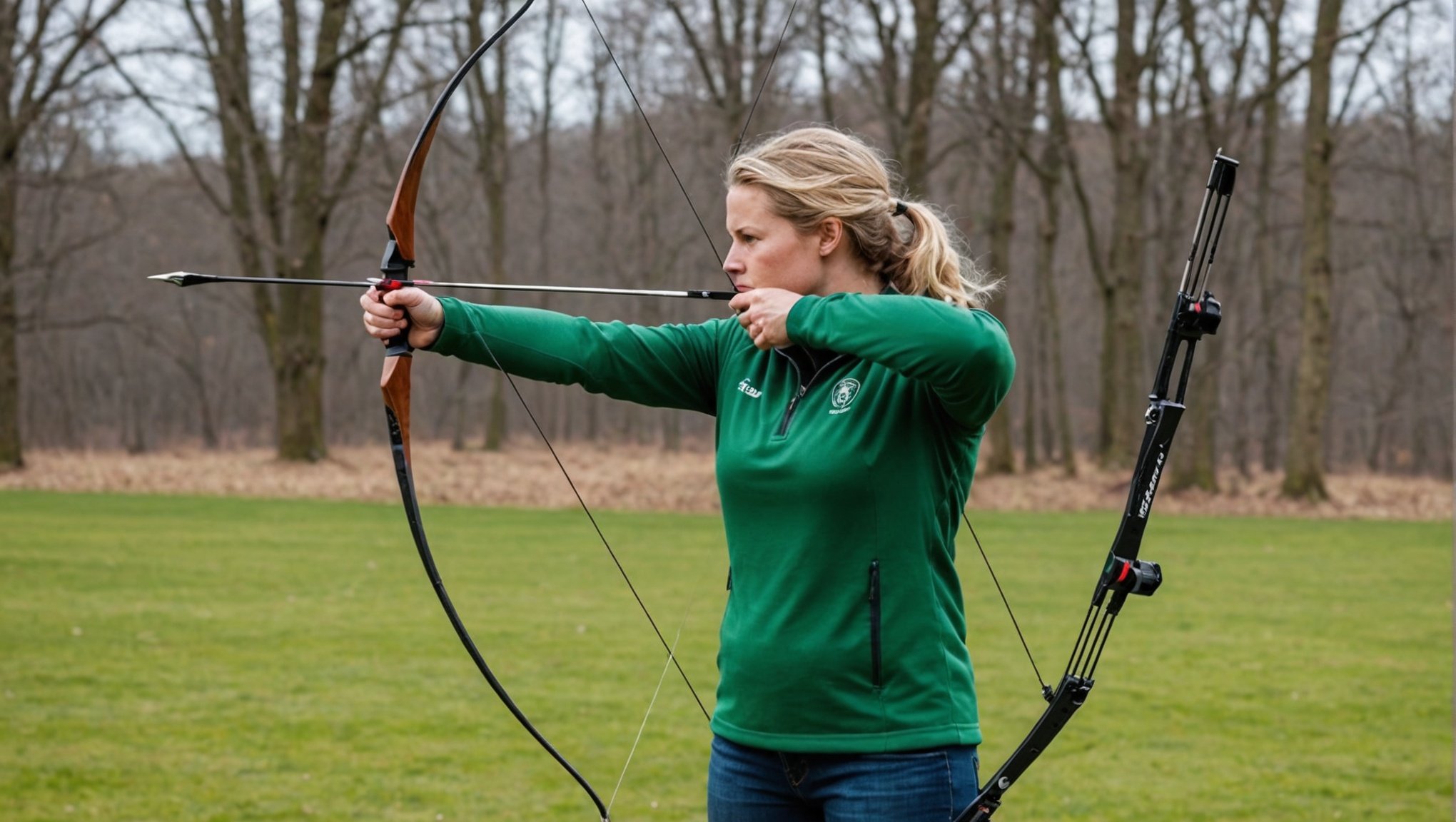Mastering Windy Shots: Effective Technique Adjustments for Archers to Boost Accuracy
Understanding the Challenge of Windy Conditions
When it comes to archery, few factors can be as daunting as shooting in windy conditions. The unpredictable gusts of wind can significantly affect the trajectory of your arrow, making it a real test of skill and adaptability for even the most experienced archers. However, with the right techniques and adjustments, you can improve your accuracy and become a more consistent shooter, even in the face of windy conditions.
The Impact of Wind on Archery
Wind can affect your shot in several ways. It can push the arrow off course, reduce its speed, and even alter its flight path mid-air. Here are some key points to consider:
Also read : Discover the excitement of shotgun gel blasters now
- Direction and Speed: Wind direction and speed are crucial. A headwind will slow down the arrow, while a tailwind will speed it up. Crosswinds, on the other hand, will push the arrow to one side.
- Arrow Weight and Type: Lighter arrows are more susceptible to wind, while heavier arrows are more stable but may still be affected.
- Shooting Distance: The farther the target, the more significant the impact of wind on the arrow’s trajectory.
Adjusting Your Technique for Windy Conditions
To master windy shots, you need to make several adjustments to your technique. Here are some key areas to focus on:
Proper Stance and Posture
Your stance and posture are the foundation of your shooting form. In windy conditions, maintaining proper form is even more critical.
In parallel : Mastering Precision: Enhancing Accuracy in Professional Darts Through Mental Training Techniques
- Stance: Ensure your feet are shoulder-width apart and your body is balanced evenly between both feet. This stability will help you resist the effects of wind.
- Posture: Keep your back straight and your core engaged. This will help maintain a consistent anchor point and reduce the impact of wind on your shot.
Anchor Point and Consistent Draw
The anchor point is the position where you consistently place your drawing hand on your face or body. This point is crucial for accuracy and must be maintained even in windy conditions.
- Consistent Anchor: Use a consistent anchor point to ensure that your draw length and draw weight are the same every time. This helps in developing muscle memory, which is essential for accurate shooting.
- Draw Length: Make sure your draw length is consistent. A longer draw length can provide more power but may be more affected by wind. Adjust your draw length based on the wind conditions and your personal comfort.
Adjusting for Wind
When shooting in windy conditions, you need to compensate for the wind’s effect on your arrow.
- Windage Adjustment: If you’re shooting in crosswind, you’ll need to adjust your aim to compensate for the wind pushing the arrow off course. This can be done by aiming slightly into the wind.
- Elevation Adjustment: Headwinds and tailwinds can affect the arrow’s speed and trajectory. Adjust your elevation accordingly to ensure the arrow reaches the target.
Here is a detailed list of adjustments you can make:
- Light Crosswind:
- Aim slightly into the wind.
- No significant elevation adjustment needed.
- Strong Crosswind:
- Aim more significantly into the wind.
- Consider reducing draw weight to minimize deflection.
- Headwind:
- Increase elevation slightly to compensate for reduced speed.
- Use a heavier arrow if possible.
- Tailwind:
- Decrease elevation slightly to compensate for increased speed.
- Use a lighter arrow if possible.
Breathing Techniques and Mental Focus
Breathing and mental focus are often overlooked but are crucial components of accurate shooting, especially in windy conditions.
Breathing Techniques
Proper breathing can help you relax and maintain focus.
- Deep Breathing: Take deep breaths before your shot to calm your nerves and steady your hand.
- Exhalation: Exhale slowly as you draw and aim. This helps in maintaining a steady hand and reducing tremors.
Mental Focus
Mental focus is key to maintaining accuracy in any shooting condition.
- Focus Concentration: Concentrate on your target and maintain a consistent aiming point. Avoid distractions and keep your mental focus sharp.
- Positive Self-Talk: Encourage yourself with positive affirmations. This can help in building confidence and maintaining a calm state of mind.
Choosing the Right Equipment
The right equipment can significantly help in improving your accuracy in windy conditions.
Bow Type
Different types of bows have different characteristics that can affect their performance in windy conditions.
- Compound Bow: Compound bows are generally more stable and less affected by wind due to their design and the use of cams and pulleys.
- Recurve Bow: Recurve bows are more traditional and can be more susceptible to wind. However, with proper technique and adjustments, they can still be very accurate.
Arrow Selection
The type and weight of the arrow can also impact its performance in windy conditions.
- Arrow Weight: Heavier arrows are generally more stable in windy conditions but may require more draw weight.
- Arrow Type: Carbon arrows are lighter and faster but more susceptible to wind. Aluminum arrows are heavier and more stable but slower.
Here is a comparative table of different arrow types and their characteristics:
| Arrow Type | Weight | Speed | Stability in Wind |
|---|---|---|---|
| Carbon | Light | Fast | Less Stable |
| Aluminum | Heavy | Slow | More Stable |
| Hybrid | Medium | Medium | Balanced |
Practice and Training
Practice is essential to mastering any skill, and archery is no exception. Here are some tips to help you improve your accuracy in windy conditions through practice:
Gap Shooting
Gap shooting involves aiming directly at the target without using a sight. This technique helps in developing instinctive shooting skills and can be particularly useful in windy conditions.
- Instinctive Shooting: Practice shooting instinctively without relying on sights. This helps in developing muscle memory and improving your ability to adjust for wind.
- Short and Long Distances: Practice shooting at both short and long distances to get a feel for how wind affects your shots at different ranges.
Regular Practice
Regular practice helps in maintaining and improving your skills.
- Consistent Practice: Practice regularly to maintain and improve your technique. Consistency is key to developing muscle memory.
- Wind Simulation: If possible, practice in simulated windy conditions to get accustomed to the effects of wind on your shots.
Real-Life Examples and Anecdotes
Here are a few examples and anecdotes that illustrate the importance of technique adjustments in windy conditions:
Professional Archers
Professional archers often face windy conditions in competitions. Here’s what one professional archer has to say about adjusting for wind:
“Wind is one of the most challenging factors in archery. To adjust, I focus on maintaining a consistent anchor point and adjusting my aim based on the wind direction and speed. It’s all about practice and experience,” says Sarah, a competitive archer.
Personal Experience
In a personal anecdote, a beginner archer shared their experience of shooting in windy conditions:
“I was at an archery range on a windy day and was struggling to hit the target. My coach advised me to adjust my aim and use a heavier arrow. With these adjustments, I was able to improve my accuracy significantly. It was a great learning experience,” says John, a beginner archer.
Mastering windy shots in archery requires a combination of proper technique, the right equipment, and mental focus. By understanding the impact of wind, adjusting your technique accordingly, choosing the right equipment, and practicing regularly, you can significantly improve your accuracy even in the most challenging conditions.
Remember, as any experienced archer will tell you, “It’s not just about hitting the target; it’s about the journey, the practice, and the continuous improvement.” With dedication and the right approach, you can become a skilled archer capable of handling any condition that comes your way. So, grab your bow, head to the range, and let the wind be your challenge rather than your obstacle.











